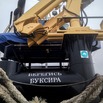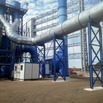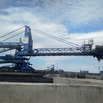Coal handling in Vanino: next move is that of Russian Railways
Daltransugol JSC (a company of NTC JSC) is set to increase its terminal capacity to 40 million by 2025 through implementation of a large-scale investment plan. However, its loading will particularly depend on implementation of Russian Railways’ plans to develop the Eastern Polygon.
IAA PortNews correspondent visited the port of Vanino to learn about specific measures undertaken by the company to boost its throughput.
Over the eight-month period of the current year, coal shipments from the terminal of Daltransugol totaled 12.5 million tonnes with the annual result forcasted to reach 18 million tonnes. As compared with the record-high result of 2020 when the terminal handled 23.3 million tonnes, the year of 2021 saw a decrease to 19 million tonnes, the year of 2022 – to 17 million tonnes. That is due to the construction of VaninoTransugol terminal which took over about 12 million tonnes of coal and to the limited capacity of the currently single-track railway.
According to Vladimir Dolgopolov, Executive Director of Daltransugol, the programme on building up the terminal’s capacity to 40 million tonnes by 2025 foresees over RUB 24 billion of investments including RUB 5.5 billion allocated for the preparation phase, RUB 2.2 billion invested in railway infrastructure and RUB 12 billion yet to be spent for equipment, its assembling, construction of new facilities. First of all, the resources are to be spent for acquisition of a car dumper.
As of today, Vladimir Dolgopolov says, the terminal has a capacity of 33 million tonnes. However, shipment of those volume is currently no possible since the reconstruction of the railways has not been finished yet.
Another reason is the new approach to production. The effectiveness was re-evaluated with the help of experts in mathematical modelling.
“The modelling showed that the existing warehouse of up to 1-1.5 million tonnes in capacity (depending on the number of coal grades) can be expanded by 100 thousand tonnes and an extension of the current stacker-reclaimer would suffice,” said Vladimir Dolgopolov.
Today, the terminal accepts about 650-850 railway cars per day depending on the season and its berths handle 16 bulkers per month on the average as they are able to load two vessels simultaneously. Efficiently organized operation of the terminal lets it ship 40 million tonnes per year.
Among the problems hindering implementation of the investment are the sanctions imposed a year and a half ago and affecting various activities. First of all, it disrupted the plans on acquisition of a car dumper. Initially, it was planned to buy a triple-car dumper from the German company ThyssenKrupp but this idea had to be dropped due to the sanctions.
“Fortunately, the entire underground part of the car dumper was received before the sanctions. The rest, unfortunately, has not been delivered. A tender has already been held for the supply of the triple car dumper and a contract has been prepared with a supplier from China. By the way, such dumpers can be manufactured in Russia as well. We are waiting for the decision of the Board of Directors. Underway is also a tender for the excavation works,” said the Executive Director.
According to him, the import substitution is going on successfully with some 80% of the entire equipment available today.
As for the environmental aspect, Vladimir Dolgopolov mentioned a number of technological solutions that minimize the harmful impact - eight stationary guns for dust suppression, two mobile and three sprinkler machines, spraying cannons installed on all loading and handling machines, a system for covering coal with foam installed on the underground conveyor, a special dust control system on car dumpers. The latter is combined with the system for briquetting of coal dust (2 tonnes of briquettes can be produced after unloading of 50 tonnes of coal).
“Moreover, we are completing the construction of wind screens. Phase 1 — 900 meters of the screen – will be completed by the end of 2023. The next 950 meters will be built by mid-2025 with the construction of the remaining 1-kilometer long screen to be postponed to 2027 as it not under the influence of the prevailing winds,” said Vladimir Dolgopolov.
When speaking about the development of exports, he emphasized that the geography of exports has narrowed over the recent year: “Previously, China accounted for one third as well as Japan with the rest distributed between the Korean Republic, India and the EU countries. Now, we have about six major consumers: China, Korea, India, Malaysia, Taiwan and Vietnam with China accounting for about a half of our exports.”
|
The participants of the recently held Eastern Economic Forum (EEF-2023) spoke a long-term about the insufficient capacity of the railways in the Far East. That issue was discussed by the regional authorities, representatives of the stevedoring business, and exporters. According to the Khabarovsk Territory Goveernor Mikhail Degtyaryov, the problem has led to the suspension of port projects with an aggregate annual capacity of 56 million tonnes. The Primorsky Territory suffers from the same problem. The capacity of its ports can at least double by 2030 with the implementation of all the investment projects. However it is not synchronized with the railway development. Russian Railways seems to see no solution so far. Aleksey Shilo, Deputy General Director, Head of Corporate Transportation Services at Russian Railways, said during one of the EEF sessions that the situation with the railways in the Far East is similar to that with roads in Moscow: the more roads, the more cars. The demand will always exceed the supply, he believes. |
Photo by IAA PortNews











